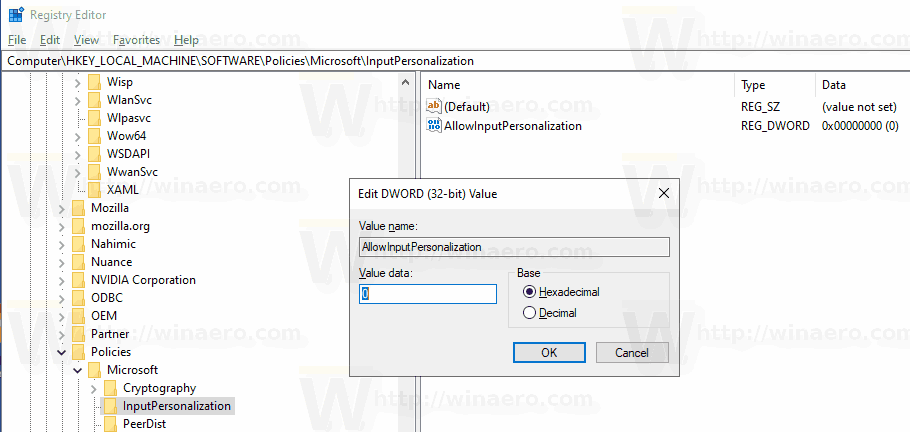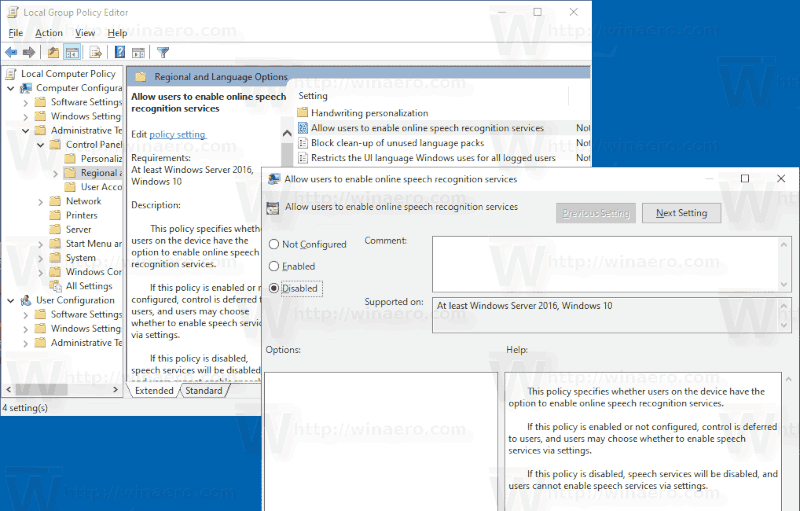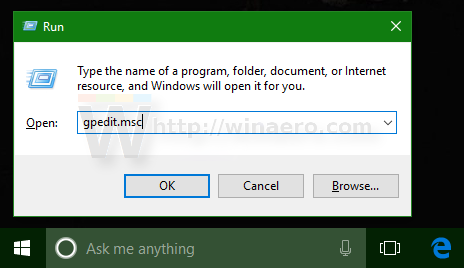Windows provides both a device-based speech recognition feature (available through the Windows Speech Recognition Desktop app), and a cloud-based speech recognition service in those markets and regions where Cortana is available. Microsoft may use the voice data collected on your computer to help improve their speech services. Windows 10 allows disabling Online Speech Recognition with a Group Policy. In this article, we will review how to apply the restriction using both gpedit.msc and a Registry tweak.
Advertisеment
Windows Speech Recognition lets you control your PC with your voice alone, without needing a keyboard or mouse. There's a special wizard to help you get started. You need to plug in your microphone, and then configure Windows Speech Recognition. Speech Recognition is a nice addition to the dictation feature of Windows 10.

Speech Recognition is only available for the following languages: English (United States, United Kingdom, Canada, India, and Australia), French, German, Japanese, Mandarin (Chinese Simplified and Chinese Traditional), and Spanish.
To use speech recognition, the option Getting to know you (the privacy setting under Speech, inking & typing) must be turned on because speech services exist both in the cloud and on your device. The info Microsoft collects from these services helps to improve them. Speech services that don’t rely on the cloud and only live on your device, like Narrator and Windows Speech Recognition, will still work when this setting is turned off, but Microsoft won’t collect any speech data.
When your Diagnostic and usage data setting (Settings > Privacy > Diagnostics & feedback) is set to Full, your inking and typing input data is sent to Microsoft, and the company use this data in the aggregate to improve the inking and typing platform for all users.
If you are interested in disabling Online Speech Recognition with Group Policy, follow the instructions below. You must be signed in with an administrative account to continue.
To Disable Online Speech Recognition with Group Policy in Windows 10,
- Open Registry Editor.
- Go to the following Registry key:
HKEY_LOCAL_MACHINE\SOFTWARE\Policies\Microsoft\InputPersonalization
Tip: See how to jump to the desired Registry key with one click.
If you do not have such a key, then just create it.
- Here, create a new 32-bit DWORD value AllowInputPersonalization. Note: Even if you are running 64-bit Windows, you still need to use a 32-bit DWORD as the value type.
Leave its value data as 0.
- Restart Windows 10 to apply the restriction, and you are done.
You are done. This methods works in all editions of Windows 10.
To save your time, I made ready-to-use Registry files. You can download them here:
The undo tweak is included.
Disable Online Speech Recognition with Gpedit.msc
If you are running Windows 10 Pro, Enterprise, or Education edition, you can use the Local Group Policy Editor app to configure the options mentioned above with a GUI.
- Press Win + R keys together on your keyboard and type:
gpedit.msc
- Group Policy Editor will open. Go to Computer Configuration\Administrative Templates\Control Panel\Regional and Language Options.
- Double-click the option Allow users to enable online speech recognition services and set it to Disabled.

- Click Apply and OK.
That's it.
Note: If you run into trouble with reverting any Group Policy option, see how to Reset all Group Policy options in Windows 10.
Articles of interest:
- Change Speech Recognition Profiles in Windows 10
- Disable Document Review for Speech Recognition in Windows 10
- Enable Voice Activation for Speech Recognition in Windows 10
- Change Speech Recognition Language in Windows 10
- Speech Recognition Voice Commands in Windows 10
- Create Start Speech Recognition Shortcut in Windows 10
- Add Speech Recognition Context Menu in Windows 10
- Enable Speech Recognition in Windows 10
- Run Speech Recognition at Startup in Windows 10
- Disable Online Speech Recognition in Windows 10
- How to Use Dictation in Windows 10
Support us
Winaero greatly relies on your support. You can help the site keep bringing you interesting and useful content and software by using these options:

